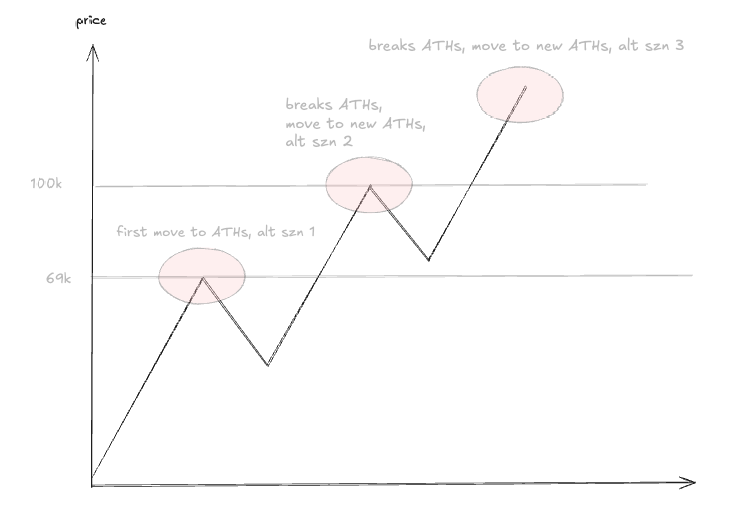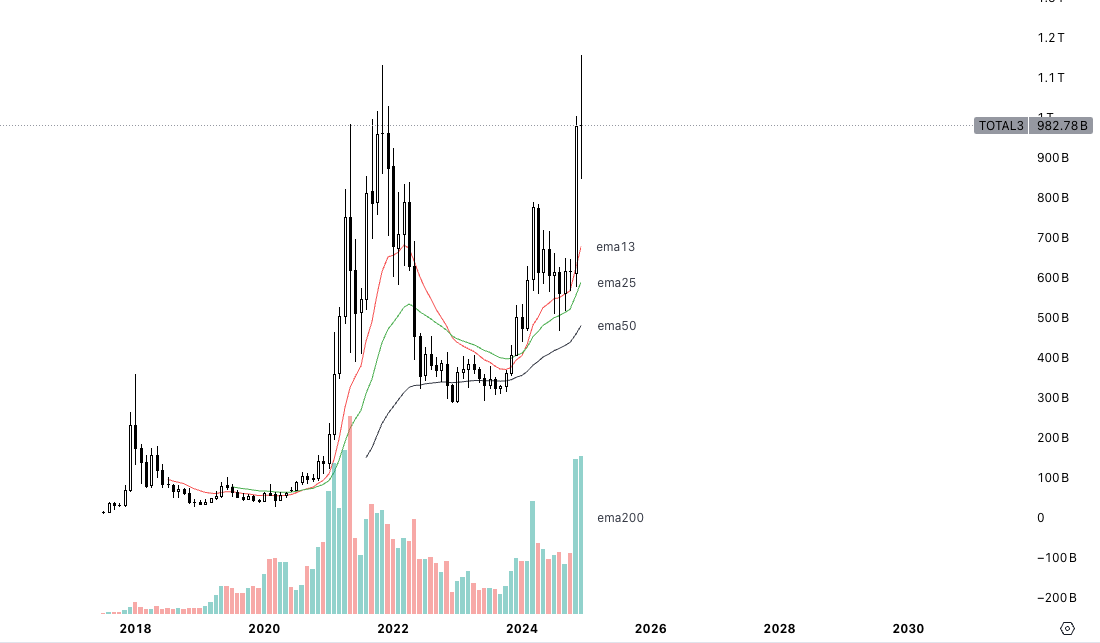Year-end series: 4 scenarios and 11 predictions for the market in 2025
Author: Kyle , Crypto Researcher
Compiled by: Felix, PANews
Since this bull market cycle started in 2024, the cycle so far is: BTC ETF launched on January 10 → until Bitcoin hits a new all-time high, boosting the alt season and entering the volatile second/third quarter of 2024, Bitcoin continues to break through $50,000 and $60,000, and is currently hovering around $90,000.
It is worth noting that the alt season started when BTC reached its highs, the first round was BTC moving towards $69,000 but failed to break out properly, and the next round was moving towards $100,000.
The next alt season is likely to be Bitcoin stabilizing at $100,000, hopefully in Q1 2025. But the Q2/Q3 2024 story could repeat itself in the coming months. Here are all the possible scenarios:

Scenario 1 : BTC + altcoins generally rise. Rising all the way through 2025, then entering another alt season, as BTC continues to rise, all tokens perform well, repeating the past 2 months, everything is rising (30-40% probability).
Strategy: Choose outperforming altcoins and buy on dips.
Scenario 2 : BTC rises, and altcoins rise less; the story of 2024 repeats itself, with fluctuations up and down in the next few months, but more bullish than 2024 (because BTC rises); so choose tokens that perform well (50-60% probability).
Strategy: Buy on dips in selected altcoins. Avoid the hottest tracks and find the next “get-rich-quick coin”
Scenario 3 : BTC rises and altcoins generally fall (20-30% probability).
Strategy: Sell all altcoins. Reduce altcoin investments; if the altcoins you hold do not rise over a long period of time, you may have to sell them all.
Scenario 4 : BTC falls, altcoins fall across the board. Everything has peaked (10-20% probability).
Because of the macro positives, a new BTC ATH breakthrough may not take as long as 2024. In this hellish summer, ETFs have just been launched, and TradFi is still struggling to sell the BTC story to customers. Most importantly, the outside world generally does not believe in the importance of Bitcoin.
Now that Trump has won the election, discussions about strategic Bitcoin reserves are underway. Although the possibility of establishing a strategic Bitcoin reserve is small, the reputation of Bitcoin has changed.
It’s the narrative that matters — the fact that we’re in a new regime has brought new attention to the digital asset space, and now that the next US president is talking about Bitcoin so frequently, makes it a lot easier to convince people to buy Bitcoin.
This regime change is extremely important. Therefore, BTC will continue to have a tailwind in 2025. For altcoins, the situation is similar, but different.

Total3 (total market cap of all altcoins) hits a 2021 all-time high in Q1 2024, then reaches a cycle high in Q4 2024. It more or less follows the same pattern (Scenarios 1 and 2 above are not too different).
The key is positioning and timing. Although I am optimistic about 2025, I don’t know how long it will take. Although the rise in 2025 may be earlier than 2024, altcoins will still fall sharply in the absence of catalysts.
As long as the cycle is not over, stay long, whether it is Bitcoin or altcoins. There will be no summer 2024 in 2025, and although there may be periods like now (just a plateau), prices will still hold up pretty well.
The situation is different on-chain, which can easily see a 70% drop when the tide recedes. It is expected that altcoins have not peaked at this time because it is not seen how BTC can continue to rise when altcoins "die", nor can it be seen that BTC has peaked here.
in conclusion:
- BTC rises, gains exceed 2024
- Altcoins are on the rise, and although there will be a decline, the magnitude will not be as strong as in 2024
risk
Cycle Top
We are nowhere near a cycle top at this time but must continue to reassess each week. A cycle top is not necessarily an "event" but more of a range that is slowly approached over time.
Bitcoin Reserve Program Risks
As the new presidential term begins, all eyes will be on what Trump says and does. While the upside for Bitcoin is there, it would be quite bearish if Trump completely ignores the reserve plan. A more likely scenario is that the reserve plan does not happen/is delayed by something.
In the latter case: as long as it is in favor of Bitcoin, it is initially a bearish, but ultimately a bullish event.
TLDR: Bullish signal = cycle continues. Bearish signal = plans must be revised. The cycle may continue, but the chances are lower.
Supply Risk
The summer of 2024 saw a crazy macro environment with stocks hitting new highs. However, due to supply giants like Mt. Gox, Grayscale GBTC, etc. hitting them again and again, there was no benefit, only harm.
Supply risk is never mitigated. There are always people who own a lot of Bitcoin - the UK government, Silk Road, FTX distribution, etc. It's just something you have to keep an eye on, but if everything goes well, these events are great dip buying events.
Macro risks
Expecting a smaller rate cut is less optimistic, but the fact is that as long as rates continue to fall, liquidity will improve. Again, bullish signal = cycle continues. Unless there are rate hikes/no rate cuts, macro should be positive for digital assets.
The bearish signal is that inflation is picking up again and the Fed may have to raise interest rates to reduce inflation.
Token Recommendation
1. AI
There have been several waves. The next wave is expected to arrive soon. Buying and holding will not end well. Goat, the token that gave birth to it all, has fallen 60% from its highs and is likely to continue to underperform.
Top picks: Applied Technology / Swarms / Gaming / Consumer-focused AI
ALCH (game development), Griffain (agent that helps control wallets), Digimon, Ai16z, etc. are all preferred.
2. DeFi
DeFi will continue to be a great narrative, however it is very difficult to invest in as few tokens will benefit from it and even if they do they may not rise significantly.
Frankly speaking, DeFi is not the first choice in terms of risk-return.
Preferred: AAVE / ENA / Morpho / Euler / USUAL
Second Choice: Stablecoins/Payment-related Tokens
3. L1
L1 will make a comeback. The obvious one is Hype. L1 itself is something the market has been ignoring - it's one of those areas no one is paying attention to, but there is a huge opportunity (just like Hype grew 10x).
First choice: SUI / Hype
Runner-up: Abstract
4. NFT Tokens and Game Tokens
The NFT token space is worth watching. PENGU is slowly picking up, Azuki has ANIME tokens, Doodles has… whatever it is. NFTs are not expected to have a resurgence, but tokens will return. Also, it’s fun to dig deeper to find interesting games with upcoming tokens.
Top picks: Pengu / Anime (Azuki) / Spellborne / Treeverse
Second Choice: Prime / Off the grid (if tokens are released) / Overworld
5. Other narratives
- Datatokens: Kaito / Arkm
- Meme: PEPE
- DePIN: PEAQ/HNT
- Ordinals
- Old DeFi: CRV/CVX
2025 Prediction
- DePIN will be implemented by a company in some way, perhaps through an acquisition.
- Binance will lose market share as the largest exchange. Not from Hyperliquid, but from Bybit/OKX
- As VR advances, Metaverse tokens gain new life
- ICOs Are Great Again
- ETH alt season will not happen
- Sui reaches double digits (minimum $10)
- Ethereum ETF staking approved, giving rise to more yield products for staking other tokens, as well as yield aggregators
- A big-name artist uses NFTs and tokens to retain and reward fans
- Bitcoin reaches $200,000
- More CEOs/founders of L1 institutions left their original companies after seeing the departure of Aptos Labs CEO ( PANews Note: On December 20 , Aptos Labs co-founder Mo Shaikh resigned as CEO, and co-founder Avery Ching will take over)
- Base lost the competition with L1s, and another L1 took over. Solana continues to maintain
Related reading: 2024 Bitcoin Year-end Review: The price of the currency rose by 131%, which is less than last year, and the TVL surged 21 times to more than US$6.7 billion
You May Also Like

Botanix launches stBTC to deliver Bitcoin-native yield

Summarize Any Stock’s Earnings Call in Seconds Using FMP API
